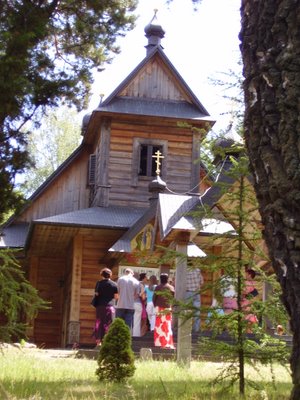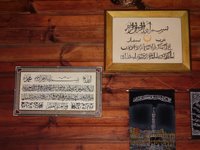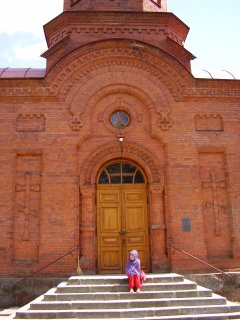Taking (bad) pictures of rituals and holy places. Anthropologist vs. tourist

Friday 30th of June we went to Holy Mount of Grabarka (only in Polish, in English here) and the Orthodox Church of the Transfiguration. The place is the most important orthodox sanctuary in Poland. It is situated in the eastern part of country, close to Siemiatycze, near border with Belarus. Celebrity of the feast of the Transfiguration is one of the 12 important holidays in orthodox ecclesiastical calendar. The date of our arrival is important to mention because it was the 10th Friday from Easter. It means it was the day of exceptional Holy Liturgy to which Orthodox people from Poland and Belarus come. We didn't actually know about the celebration and didn't suppose we were going to participate (?!) in an important religious event. Especially that on our way to sanctuary we didn't meet too much pilgrims:)






In his article Jay Ruby writes "If "taking pictures" is an anthropological activity, It would seem quite reasonable to expect to find a body of literature which demonstrates that anthropological picture-taking is scientifically justifiable." As I was just a "tourist" there, it is hard to find any justification for taking pictures there.
Another thing is where the boundary between being a tourist and being an anthropologist lays???? There are tourists who are interested in the culture and social situations one experiences and there are anthropologists that are not doing any FORMAL research or fieldwork at the place at which they are. Any place I visit for the first time provoke some thoughts that could be labeled as "anthropological" - that means that I try to find patterns, structures, functions, reasons, contexts in what I am witnessing. I adore anything new and I easily fall in love with the new situations and social beings. It gives me the power to explore new subjects and wake my interest in new themes. That feeling makes me interested in people's life and makes me want to understand them. Am I a tourist then or an anthropologist? I think that the difference is in what we do with those feelings later, when we are back from those places...... (I need to go deeper into this subject).
Anyway, I think that being an anthropologist requires a good dose of self-esteem and humility at the same time.
As a conlusion I want to quote Ruby and put pictures that, I think, illustrate almost literally what he calls "photographic presentation of self":
"When an anthropologist, or anyone else for that matter, takes a picture he follows a set of culturally specific conventions which determine the selection of subject matter and the treatment of that subject. In addition, the subject, if he is a member of a culture where pictures are normally taken, follows another set of "on camera" behaviors which shape his photographic presentation of self (my emphasis)."
"If asked, most anthropologists would separate themselves from the tourist photographer by saying that they have a scientific obligation to pictorially record any culture under study because that culture will undoubtedly undergo rapid change and they need to preserve this record for the future. This assumed responsibility and justification do cause us to take some pictures that the average tourist would not."




See also - Taking pictures movie.

At the Holy Spring there wasn't anybody either...


So it was to our great surprise that when went up the hill to visit the church and the mount of crosses we met the congregation devoted to listening to the sermon and songs. And here THE BAD PHOTOGRAPHY began...



 As you can see I didn't use too much time and energy to adjust my camera, to bring the image into focus, to wait for the right light, composition and so on (I am not any artistic or technical talent at all but I allways try a little bit more:). Suddenly I became conscious of being at a holy place. A place that is important to the assembled in a way that needs respect, understanding and distance. I felt ill at ease taking pictures highlighting my "strangeness" there. From somebody who wanted to see and experience the holy place, I transformed to a nosy tourist that poked her head in there. I felt like a spion in a place that deserves some special treatment. I didn't feel well. That is why I took some shots that are so crummy. Pictures that express my discomfort and my position there. The photos above show how I've tried to document what I saw but I didn't have enough courage and knowledge to make THE GOOD (aesthetic) DOCUMENT...
As you can see I didn't use too much time and energy to adjust my camera, to bring the image into focus, to wait for the right light, composition and so on (I am not any artistic or technical talent at all but I allways try a little bit more:). Suddenly I became conscious of being at a holy place. A place that is important to the assembled in a way that needs respect, understanding and distance. I felt ill at ease taking pictures highlighting my "strangeness" there. From somebody who wanted to see and experience the holy place, I transformed to a nosy tourist that poked her head in there. I felt like a spion in a place that deserves some special treatment. I didn't feel well. That is why I took some shots that are so crummy. Pictures that express my discomfort and my position there. The photos above show how I've tried to document what I saw but I didn't have enough courage and knowledge to make THE GOOD (aesthetic) DOCUMENT...

When I saw the pictures after I came home I was amazed over what the pictures actually showed! They are bad as documents of the celebration and don't have any aesthetic qualities but they are perfect as an evidence for my presence there and what my position was there and then - an observer, somebody hidden, who didn't want to be nailed. The camera was matter out of place as well as I was. In my perspective. As a newcomer, as a stranger, as an outsider, I wasn't sure how far I can go not to hurt anybody. Not to destroy the holisness of the moment. That is why I am not sure if I can work with "holy" things, places, rituals and others. I just couldn't wipe off the feeling of intrudeness out of my head. I think that my sense of empathy dominates over my voice of reason. I hope it is true what every experienced fielworker says that it's just a metter of training and practice to find the balance between those two. I know also that the fact that I was so focused on myself made me feel so uncomfortable. Now I am quite sure that those people probably didn't bother about my presence and what I was trying to do. But there and then I had a feeling that everybody looked at me and didn't say nothing but thought that I was a really rude tourist!
The other fact is that I didn't know anything about "taking pictures rules" there and I didn't ask anyone about that. I felt awfully weird. As a lot of fieldworkers ask themselves: Do I have the right? (see for example Belomonte or Scheper-Hughes) I asked myself also. I don't know the answer, I don't know exactly what I was doing there and why, but I've discovered next truth of being a moral scientist:
IF YOU DOUBT IF WHAT YOU ARE DOING IS RIGHT, DON'T DO THAT, YOU CAN LIVE WITHOUT THAT. IF YOU DON'T KNOW THE NEW SITUATION AND YOU ARE NOT SURE ABOUT CULTURAL NORMS THERE - DON'T DO ANYTHING THAT CAN GIVE YOU BAD CONSCIENCE. YOUR PEACE OF MIND AND MORAL SELFDISCIPLINE IS A POINT OF DEPARTURE FOR MAKING GOOD SCIENCE AND THE WORLD BETTER.


So it was to our great surprise that when went up the hill to visit the church and the mount of crosses we met the congregation devoted to listening to the sermon and songs. And here THE BAD PHOTOGRAPHY began...



 As you can see I didn't use too much time and energy to adjust my camera, to bring the image into focus, to wait for the right light, composition and so on (I am not any artistic or technical talent at all but I allways try a little bit more:). Suddenly I became conscious of being at a holy place. A place that is important to the assembled in a way that needs respect, understanding and distance. I felt ill at ease taking pictures highlighting my "strangeness" there. From somebody who wanted to see and experience the holy place, I transformed to a nosy tourist that poked her head in there. I felt like a spion in a place that deserves some special treatment. I didn't feel well. That is why I took some shots that are so crummy. Pictures that express my discomfort and my position there. The photos above show how I've tried to document what I saw but I didn't have enough courage and knowledge to make THE GOOD (aesthetic) DOCUMENT...
As you can see I didn't use too much time and energy to adjust my camera, to bring the image into focus, to wait for the right light, composition and so on (I am not any artistic or technical talent at all but I allways try a little bit more:). Suddenly I became conscious of being at a holy place. A place that is important to the assembled in a way that needs respect, understanding and distance. I felt ill at ease taking pictures highlighting my "strangeness" there. From somebody who wanted to see and experience the holy place, I transformed to a nosy tourist that poked her head in there. I felt like a spion in a place that deserves some special treatment. I didn't feel well. That is why I took some shots that are so crummy. Pictures that express my discomfort and my position there. The photos above show how I've tried to document what I saw but I didn't have enough courage and knowledge to make THE GOOD (aesthetic) DOCUMENT...
When I saw the pictures after I came home I was amazed over what the pictures actually showed! They are bad as documents of the celebration and don't have any aesthetic qualities but they are perfect as an evidence for my presence there and what my position was there and then - an observer, somebody hidden, who didn't want to be nailed. The camera was matter out of place as well as I was. In my perspective. As a newcomer, as a stranger, as an outsider, I wasn't sure how far I can go not to hurt anybody. Not to destroy the holisness of the moment. That is why I am not sure if I can work with "holy" things, places, rituals and others. I just couldn't wipe off the feeling of intrudeness out of my head. I think that my sense of empathy dominates over my voice of reason. I hope it is true what every experienced fielworker says that it's just a metter of training and practice to find the balance between those two. I know also that the fact that I was so focused on myself made me feel so uncomfortable. Now I am quite sure that those people probably didn't bother about my presence and what I was trying to do. But there and then I had a feeling that everybody looked at me and didn't say nothing but thought that I was a really rude tourist!
The other fact is that I didn't know anything about "taking pictures rules" there and I didn't ask anyone about that. I felt awfully weird. As a lot of fieldworkers ask themselves: Do I have the right? (see for example Belomonte or Scheper-Hughes) I asked myself also. I don't know the answer, I don't know exactly what I was doing there and why, but I've discovered next truth of being a moral scientist:
IF YOU DOUBT IF WHAT YOU ARE DOING IS RIGHT, DON'T DO THAT, YOU CAN LIVE WITHOUT THAT. IF YOU DON'T KNOW THE NEW SITUATION AND YOU ARE NOT SURE ABOUT CULTURAL NORMS THERE - DON'T DO ANYTHING THAT CAN GIVE YOU BAD CONSCIENCE. YOUR PEACE OF MIND AND MORAL SELFDISCIPLINE IS A POINT OF DEPARTURE FOR MAKING GOOD SCIENCE AND THE WORLD BETTER.





In his article Jay Ruby writes "If "taking pictures" is an anthropological activity, It would seem quite reasonable to expect to find a body of literature which demonstrates that anthropological picture-taking is scientifically justifiable." As I was just a "tourist" there, it is hard to find any justification for taking pictures there.
Another thing is where the boundary between being a tourist and being an anthropologist lays???? There are tourists who are interested in the culture and social situations one experiences and there are anthropologists that are not doing any FORMAL research or fieldwork at the place at which they are. Any place I visit for the first time provoke some thoughts that could be labeled as "anthropological" - that means that I try to find patterns, structures, functions, reasons, contexts in what I am witnessing. I adore anything new and I easily fall in love with the new situations and social beings. It gives me the power to explore new subjects and wake my interest in new themes. That feeling makes me interested in people's life and makes me want to understand them. Am I a tourist then or an anthropologist? I think that the difference is in what we do with those feelings later, when we are back from those places...... (I need to go deeper into this subject).
Anyway, I think that being an anthropologist requires a good dose of self-esteem and humility at the same time.
As a conlusion I want to quote Ruby and put pictures that, I think, illustrate almost literally what he calls "photographic presentation of self":
"When an anthropologist, or anyone else for that matter, takes a picture he follows a set of culturally specific conventions which determine the selection of subject matter and the treatment of that subject. In addition, the subject, if he is a member of a culture where pictures are normally taken, follows another set of "on camera" behaviors which shape his photographic presentation of self (my emphasis)."
"If asked, most anthropologists would separate themselves from the tourist photographer by saying that they have a scientific obligation to pictorially record any culture under study because that culture will undoubtedly undergo rapid change and they need to preserve this record for the future. This assumed responsibility and justification do cause us to take some pictures that the average tourist would not."




See also - Taking pictures movie.
Labels: method, photography, Pictures, Poland, religion, rituals























